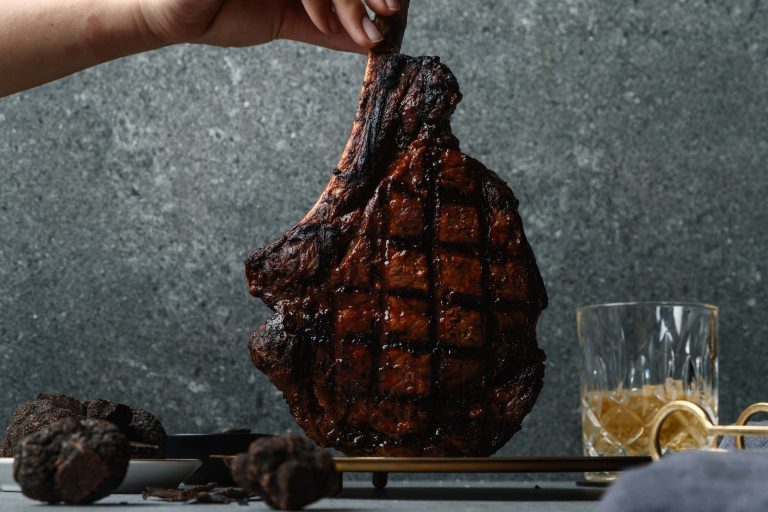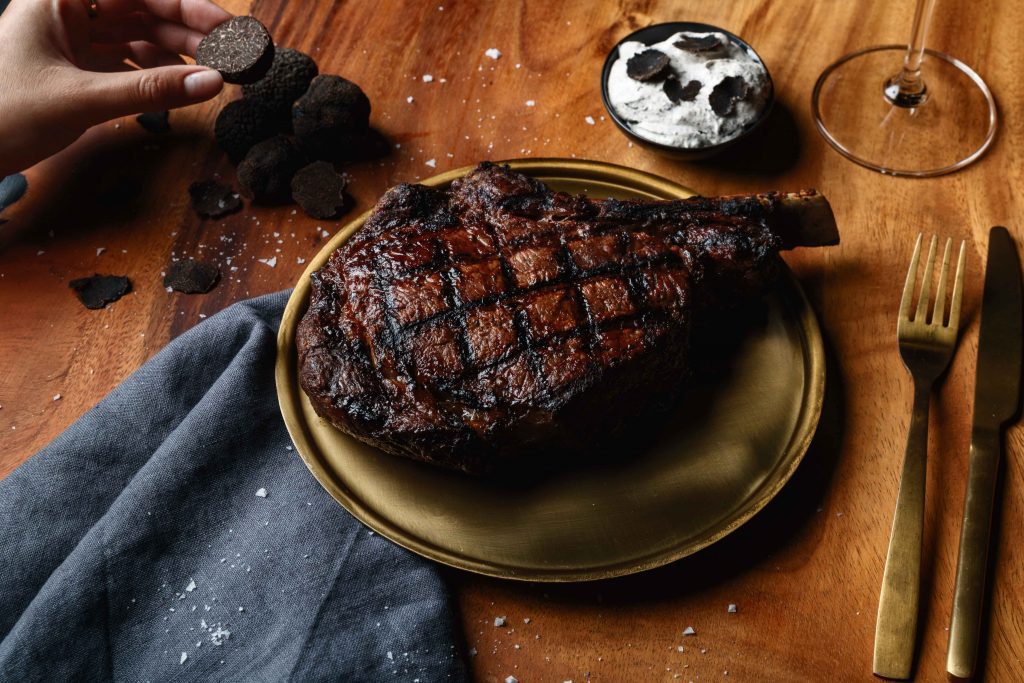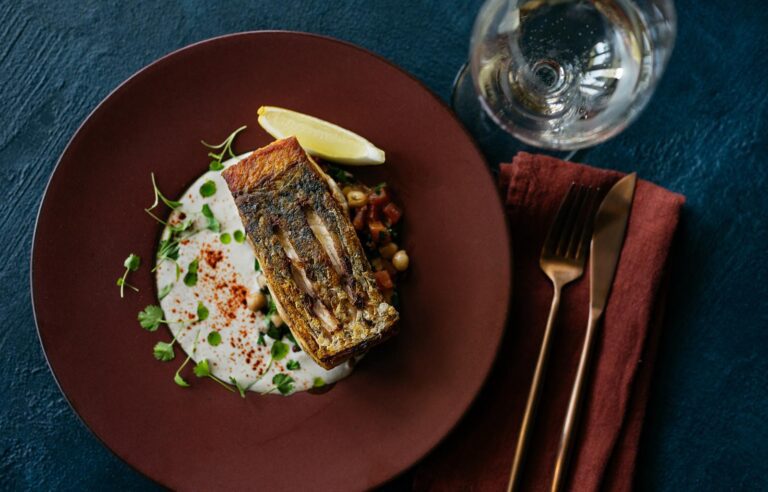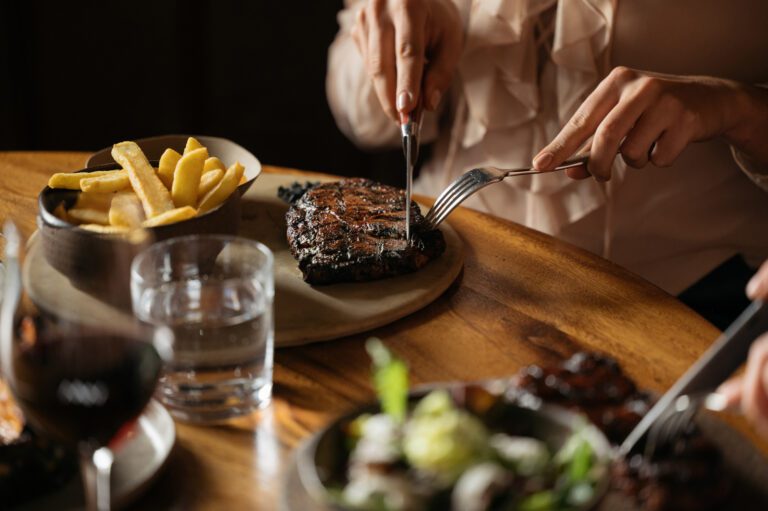Dry aged steak is on everyone’s lips this year – physically and metaphorically. This trending dish has become immensely popular in recent years as chefs have increased their knowledge not just in how to make it, but how to perfect it, too. But what is dry aged steak exactly, and what does it taste like? Read on to discover all the answers to these FAQs and more!
1. What is dry aged steak?
Dry aged steak refers to a method of preparing a cut of beef before it is cooked. As the name suggests, this involves ageing it.
Dry ageing is not the same as leaving a piece of steak in your fridge at home in order to age. It uses specialised equipment (like a fridge) that allows chefs to control the temperature and humidity around the meat, and avoid unwelcome bacteria growing on it.
Different chefs will dry age steak for different lengths of time, but it is usually more than a month at minimum. When done right, dry ageing results in spectacularly tender, flavourful steak unlike any you’ve ever tried.
2. What does dry aged steak taste like?
If you like steak, you’ll love dry aged steak.
Dry aged steak still retains those rich beefy flavours that you’ll find in a premium steak. However, dry ageing essentially amplifies all the sought-after qualities in a cut.
This means dry aged steak tastes even more beefy, more tender in texture, and richer. Additionally, it can also bring out more subtle flavours in the cut, such as buttery popcorn.
When you order a dry aged steak from The Meat & Wine Co, you will also enjoy an extra infusion of subtle flavour thanks to our unique ageing process. See question 7 for more details!
3. How is steak dry aged?
Dry ageing steak is a meticulous several step process.
It starts with pre-ageing the cut for anywhere from one to three weeks in a dry-ager. This allows a hard crust to form on the outside of the meat, stopping the inside from drying out while also protecting it from bacteria.
Next, our chefs coat the cut in a thick layer of infused butter, which allows the ageing process to continue but restricting any overwhelming strong flavours that could arise otherwise. The cut then goes back into the dry-ager for at least one month.
Finally, our chefs carefully remove the layer of butter and the crust, and cut it into steaks ready to cook and serve.
4. How long does it take to age steak?
At Meat & Wine Co, it typically takes approximately six weeks to age our premium steak.
However, some restaurants will age steak for several months, which results in a much stronger flavour.
5. What is the best way to cook dry aged steak?
The magic of the dry ageing process is all in the preparation – the actual cooking is largely the same as cooking a standard steak.
This means starting slow to cook the meat to your desired finish, then searing on each side for a perfect crunchy crust. Our chefs have this process down to a fine art, bringing out the very best in every cut for that flawless finish.
6. What is wet aged steak?
Wet ageing uses the same theory to age steak as dry ageing, but an entirely different process.
In wet ageing, steak is aged in a vacuum-sealed pack. This removes air from the cut, and allows the muscle fibres to break down and the meat to become more tender, just like with the dry ageing process.
The difference between dry and wet ageing is that unlike dry ageing, there is no moisture loss. It is also a more affordable and faster process, although wet aged doesn’t typically have the same depth of flavour as dry aged beef.
7. What is butter aged steak?
Butter aged steak is an exciting new development in aged steak, and one that you will find at Meat & Wine Co.
After pre-ageing a cut, we remove it from the dry-ager, and slather it in a thick layer of butter and animal fat. This layer acts as a protective shield around the cut, allowing the meat to continue ageing and tenderising, while stopping any moisture loss and protecting against bacteria.
The butter replaces the thick, hard crust that would naturally form on a cut of beef during the dry ageing process, which has to be cut away before serving. This means there is less meat loss, and helps us to keep the price of dry-aged steak to a level everyone can enjoy.
As an added benefit, the butter ageing process allows us to add a subtle flavour infusion, such as smoked charcoal or thyme and honey, through the butter.
8. Where can I buy dry aged steak?
Buying dry aged steak in Australia is becoming more and more accessible. You may be able to find it at specialty butcheries, but the easiest place to find it is at Meat & Wine Co.
With 10 restaurants in five cities, we offer premium dry aged steak prepared and cooked to perfection.
9. How does Meat & Wine Co dry age steak differently?
The difference in our dry aged steak is our exclusive butter ageing method.
Traditionally, dry ageing allows a natural crust to build up on the cut of beef. This is an essential part of the ageing process, but it does increase waste (and therefore cost) as it has to be cut away prior to serving.
While we allow some time for a crust to build up, we then add a layer of butter and animal fat, which mimics the effect of the crust, without the cost or wastage of meat. It also allows us to add extra flavour to each batch, which we rotate regularly for new butter-infused flavours each time you visit.
10. What is the current offer of dry aged steak at AGED by Meat & Wine Co?
The current AGED offer at Meat & Wine Co is an aged, grass-fed Monte rib-eye, which is infused with the essence of smoked charcoal. Keep up to date with our latest offer here.
Or, you can opt for a traditional grass-fed, dry aged Monte rib-eye.
These dishes are available for a limited time only, so make your booking at Meat & Wine Co to see exactly why we’re known as one of the best dry aged steak restaurants in Australia.





/assets/images/ajax-loader.gif)